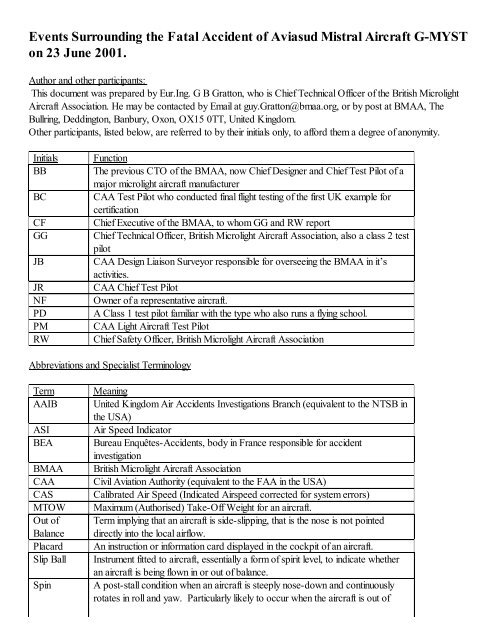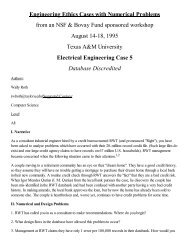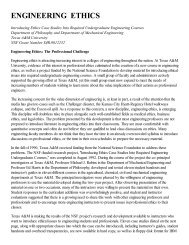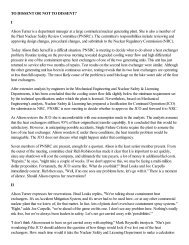Aviasud Mistral Aircraft - Engineering Ethics
Aviasud Mistral Aircraft - Engineering Ethics
Aviasud Mistral Aircraft - Engineering Ethics
Create successful ePaper yourself
Turn your PDF publications into a flip-book with our unique Google optimized e-Paper software.
Events Surrounding the Fatal Accident of <strong>Aviasud</strong> <strong>Mistral</strong> <strong>Aircraft</strong> G-MYST<br />
on 23 June 2001.<br />
Author and other participants:<br />
This document was prepared by Eur.Ing. G B Gratton, who is Chief Technical Officer of the British Microlight<br />
<strong>Aircraft</strong> Association. He may be contacted by Email at guy.Gratton@bmaa.org, or by post at BMAA, The<br />
Bullring, Deddington, Banbury, Oxon, OX15 0TT, United Kingdom.<br />
Other participants, listed below, are referred to by their initials only, to afford them a degree of anonymity.<br />
Initials<br />
BB<br />
BC<br />
CF<br />
GG<br />
JB<br />
JR<br />
NF<br />
PD<br />
PM<br />
RW<br />
Function<br />
The previous CTO of the BMAA, now Chief Designer and Chief Test Pilot of a<br />
major microlight aircraft manufacturer<br />
CAA Test Pilot who conducted final flight testing of the first UK example for<br />
certification<br />
Chief Executive of the BMAA, to whom GG and RW report<br />
Chief Technical Officer, British Microlight <strong>Aircraft</strong> Association, also a class 2 test<br />
pilot<br />
CAA Design Liaison Surveyor responsible for overseeing the BMAA in it’s<br />
activities.<br />
CAA Chief Test Pilot<br />
Owner of a representative aircraft.<br />
A Class 1 test pilot familiar with the type who also runs a flying school.<br />
CAA Light <strong>Aircraft</strong> Test Pilot<br />
Chief Safety Officer, British Microlight <strong>Aircraft</strong> Association<br />
Abbreviations and Specialist Terminology<br />
Term<br />
AAIB<br />
ASI<br />
BEA<br />
BMAA<br />
CAA<br />
CAS<br />
MTOW<br />
Out of<br />
Balance<br />
Placard<br />
Slip Ball<br />
Spin<br />
Meaning<br />
United Kingdom Air Accidents Investigations Branch (equivalent to the NTSB in<br />
the USA)<br />
Air Speed Indicator<br />
Bureau Enquêtes-Accidents, body in France responsible for accident<br />
investigation<br />
British Microlight <strong>Aircraft</strong> Association<br />
Civil Aviation Authority (equivalent to the FAA in the USA)<br />
Calibrated Air Speed (Indicated Airspeed corrected for system errors)<br />
Maximum (Authorised) Take-Off Weight for an aircraft.<br />
Term implying that an aircraft is side-slipping, that is the nose is not pointed<br />
directly into the local airflow.<br />
An instruction or information card displayed in the cockpit of an aircraft.<br />
Instrument fitted to aircraft, essentially a form of spirit level, to indicate whether<br />
an aircraft is being flown in or out of balance.<br />
A post-stall condition when an aircraft is steeply nose-down and continuously<br />
rotates in roll and yaw. Particularly likely to occur when the aircraft is out of
Stall<br />
Vso<br />
balance at the point of stall.<br />
The condition when an aircraft ceases, due to lack of airspeed, to be fully<br />
controllable as it is decelerated.<br />
The airspeed at which a decelerating aircraft ceases to be under full control in the<br />
landing configuration (termed stalling speed)<br />
Background<br />
This case study is written in the 3 rd person, but was prepared by a person directly involved in the case.<br />
Individuals involved in this process are identified only by initials, to allow them a degree of anonymity. The<br />
author is a practicing Engineer and not an academic, and therefore will leave others who would like to use this<br />
study for their own purposes, to construct their own questions or discussion material. The case discussed here is<br />
entirely real, and no facts have been modified. Inevitably many facts have been omitted, since although they are<br />
relevant only to the engineers directly involved, and not to the ethical issues of the case.<br />
The British Microlight <strong>Aircraft</strong> Association is partly a members organisation but also has delegated powers from<br />
the UK Civil Aviation Authority to oversee the airworthiness of new and existing microlight aeroplanes on the<br />
British civil register. At the time of writing, this fleet comprises about 3,100 aircraft, which include 137 types<br />
using one of three different control systems. This delegated approach is used across the lighter end of aviation in<br />
the UK, allowing a lower cost service for aircraft owners, and the CAA to concentrate on bigger more complex<br />
aircraft. The term “microlight” is defined as follows:-<br />
· For landplanes: MTOW not exceeding 450kg for 2-seat aircraft, or 300 for a single seat aircraft<br />
· For seaplanes and amphibians, MTOW not exceeding 495kg, or 330kg for a single seat aircraft.<br />
· Vso not exceeding 35 kn CAS. (In the UK only, an acceptable alternative is a wing loading not<br />
exceeding 25 kgf.m -2 ).<br />
· A maximum of 2 seats.<br />
Within the BMAA, the Chief Executive (CF) is ultimately responsible for the airworthiness function, but much of<br />
this is delegated to two individuals. GG, the Chief Technical Officer is a Chartered Aeronautical Engineer and<br />
Test Pilot, responsible for all aspects of design approval and test flying. Under him are several other Engineers, a<br />
Chief Test Pilot and Chief Check Pilot, and ultimately about 10 test pilots and 220 airworthiness check pilots.<br />
RW, the Chief Safety Inspector is a very experienced and senior technician, responsible for all aircraft<br />
inspection, in-service defect reporting, and non-fatal accident investigation issues. Responsible to him are some<br />
160 inspectors and 100 club safety officers.<br />
The <strong>Aviasud</strong> <strong>Mistral</strong> is a French aircraft that was imported into the UK in the early 1990s. The company<br />
importing the type failed after bringing about 12 aircraft into the country (of about 200 in built in France) but<br />
before obtaining “type approval” certification, that is approval for factory built aircraft. This left 12 aircraft<br />
unable to be issued with “permits to fly”, yet having been paid for by individual customers of the aircraft. After
some time, whilst these aircraft were unable to be legally flown, the investigation of these aircraft was reinvestigated<br />
by the BMAA, and ultimately they were issued with “homebuilt permits to fly”, in a legal deal<br />
between the BMAA, CAA and owners of the aircraft. This form of permit to fly implies that the aircraft have<br />
been shown to comply with the stringent UK safety standard for microlight aircraft, BCAR Section S[[1]], but<br />
does not imply that they had been manufactured by a supervised factory. The significance of this is that the<br />
aircraft were considered fit for private use, but could not legally be used for commercial flying instruction (the<br />
only form of aerial work apart from certification test flying allowed on a microlight aircraft). One significant point<br />
of this approval is that the aircraft did not display during certification handling qualities at the stall that met the<br />
safety requirements, in that it could drop a wing and show signs of an incipient spin. For this reason the fitting of<br />
an artificial stall warning device (a buzzer which sounded in the cockpit at dangerously low speeds) was<br />
mandated.<br />
Figure 1, <strong>Aviasud</strong> <strong>Mistral</strong> (example shown is not a British registered example but external appearance is<br />
identical)<br />
The Accident<br />
The pilot and owner of <strong>Mistral</strong> G-MYST had arranged to take a work colleague for a pleasure flight from his<br />
airfield in Shropshire, England on 23 June 2001. He was a qualified but not experienced pilot, being 47 years<br />
old, with 67 hours of flying experience, including 1 hour in the previous 90 days and none in the previous 28<br />
days. To set this in context, the minimum requirement to obtain a microlight pilots license is 25 hours flying<br />
training, although 35-40 is more normal [[2]].<br />
About 40 minutes into the flight the aircraft was seen by a number of witnesses flying at low level. Witnesses
thought that the aircraft was flying too slowly and two witnesses, one of whom was an experienced glider pilot<br />
thought that the aircraft was flying out of balance. Some seconds later, the aircraft was seen to yaw and roll<br />
rapidly into a steep dive before disappearing from view. One witness thought they heard the engine stop just<br />
before the aircraft apparently departed from controlled flight. Several people proceeded in the direction that the<br />
aircraft was last seen and found the aircraft wreckage almost vertically nose-down with extensive damage in the<br />
cockpit area. Both occupants were trapped in the cockpit and certified dead at the scene.<br />
Subsequent examination of the wreckage by AAIB inspectors identified the following:-<br />
- Unapproved modifications to the fuel system.<br />
- Ingress of an unidentified loose object had caused an engine failure, assumed just prior to the<br />
accident.<br />
- Supporting evidence of low speed flight prior to the accident.<br />
- The removable canopy of the aircraft was not fitted.<br />
Note – Modifications<br />
There is a system in the UK for approval of all modifications to microlight aircraft, which<br />
requires the details of the modification to be submitted and, assuming that the modification is<br />
shown to be satisfactory and compliant with the safety standard, can be approved for a low fee<br />
(normally £30, or about the cost of 1 hours flying in aircraft of this class). No such application<br />
had been made for the changes to the fuel system fitted to the aircraft. There is no indication<br />
that the modified fuel system contributed to the accident, but at-the-least it may have had<br />
potential to cause an accident. There had been a failing somewhere on the part of the current<br />
or previous owner, and possibly an inspector at the previous renewal of a permit to fly, in that<br />
this modification had been allowed to be carried out without going through a formal safety<br />
assessment process.<br />
Historical Investigations (ethical failings?)<br />
After being informed of the accident, and whilst the AAIB was conducting it’s initial field investigations, the<br />
BMAA investigated the history of the aircraft. These investigations identified a number of issues in the history of<br />
the aircraft. Specifically:-<br />
- The French BEA had a record of a similar fatal accident in 1996, they also had record of two<br />
non-fatal French occurrences of loss of control at the stall. No record could be found of these<br />
having been reported to any UK authority.<br />
- Anecdotal evidence and one formal report to the BMAA, came to light of an inadvertent spin in<br />
an <strong>Aviasud</strong> <strong>Mistral</strong>. The one formally reported incident had not been deeply investigated<br />
- The decision to accept an audible stall warning device in lieu of acceptable stalling characteristics<br />
had been recommended by BC, the test pilot who flew the aircraft for original certification. This<br />
alternative was not actually permitted by the safety standard at the time, and there was no<br />
historical record of in-depth discussion of this decision.<br />
- The aircraft was fitted with a removable canopy (see figure 1). This was not fitted, yet on<br />
investigation throughout the UK certification testing of the type the canopy had been fitted, so<br />
there was no record of what changes removing the canopy made to the handling.
There are arguably four identifiable ethical failings here. The failure of an accident investigation authority to<br />
ensure that safety data was shared with all operators of the aircraft type, the failure of the BMAA to conduct a<br />
full investigation after a departure from controlled flight, an exception being made to a safety regulation without<br />
the full conscious acceptance of all parties involved, and finally failure to restrict operation of the aircraft only to<br />
configurations that had been tested (i.e. with the canopy fitted).<br />
Subsequent investigations<br />
After their subsequent field investigations, the AAIB team held several meetings with GG, and also visited PD<br />
(who as a flying instructor had checked-out several pilots on the type). They also visited NF who provided<br />
access to his own identical aircraft so that the AAIB team could compare the exact details of items such as the<br />
stall warning device installation and the correct configuration of the fuel system. After considerable discussions,<br />
the AAIB issued the following recommendations, which the BMAA accepted…<br />
(1) The BMAA should carry out flight tests to determine the acceptability of the <strong>Mistral</strong>’s handling<br />
characteristics with the canopy removed. Further, the BMAA should not be flown with the canopy<br />
removed until these tests have been carried out. AAIB Recommendation 2001-75<br />
(2) The BMAA should review the adequacy of the current stall warning system fitted to <strong>Mistral</strong> aircraft with<br />
particular emphasis on the standard of construction and adequacy of the aural warning. The review<br />
should consider whether the aural warning should be connected to the aircraft’s intercom system. AAIB<br />
Recommendation 2001-76<br />
By the time these recommendations had been issued, GG had already written to all owners of the type in the<br />
UK, advising them of the suspicions behind the causes of the accident, and that they should not until further<br />
notice fly the aircraft with the canopy removed.<br />
Subsequently discussions were carried out between GG, PD and NF during which it was agreed that NF would<br />
provide free use of his aircraft, GG would prepare a suitable test plan, and PD would give his time for free to<br />
flight test the aircraft.<br />
The AAIB recommendations were also seen by the CAA who held their own internal meetings at which it was<br />
considered whether the type should be grounded. PM (probably the most microlight aware member of the<br />
CAA’s technical staff) went against the general trend in recommending that this was not the case, and this view<br />
eventually held sway. To consider the CAA’s mindset one should recall that this was not long after two high<br />
profile accidents, the Paris Concorde crash (leading to grounding of all of the type for some time) and the<br />
Queens / New York A310 crash, which had led to mandatory safety inspections of all aircraft of the type but not<br />
grounding.<br />
Notes – issues arising here.<br />
NF the aircraft owner, and PD the test pilot had no compulsion to give up their time and use of<br />
an aircraft for this safety investigation. They did so out of a clear desire to make a contribution<br />
to the solution of a safety problem.
The CAA position is interesting. There is an obvious reaction at the identification of any safety<br />
problem to ground aircraft possibly affected. This risk has to be balanced with the<br />
understanding that aircraft exist to be flown and by grounding them individuals are<br />
inconvenienced and money lost. The decision to allow aircraft to keep flying was probably the<br />
more difficult decision, and probably only followed from a clear willingness on the part of the<br />
BMAA to follow the AAIB recommendations thoroughly and quickly.<br />
A test plan was raised, and testing authorised using NF’s aircraft. This testing was carried out primarily by PD<br />
with GG also flying as a second test pilot. The testing covered the following, which were tested both canopy-on<br />
and canopy-off.<br />
- Airspeed indication errors<br />
- Longitudinal static stability (a basic handling characteristic which might be affected by removal of<br />
the canopy).<br />
- Lateral and directional stability (ditto)<br />
- Low speed handling<br />
- Stalling<br />
- Effects of leaning over the side of the cockpit if the canopy was removed (something obviously<br />
not possible with the canopy fitted).<br />
This testing was then delayed by several months due to a long period of bad weather (this was early winter and<br />
the nature of stall testing particularly is that high cloud and low turbulence are required, not a regular occurrence<br />
in the British Winter). The delays caused some annoyance amongst CAA staff; however, when this was<br />
eventually discussed between GG and JR, the reasons for this were accepted.<br />
Note – attitudes of senior managers<br />
This highlighted an understandable difference between the views of the <strong>Engineering</strong> staff such as<br />
JB who have no operational experience and don’t necessarily understand the realities of<br />
organising a flight test programme and why sometimes very long delays can be inevitable, and<br />
experienced pilots such as JR or PM who are fully aware of the reasons for these delays. The<br />
BMAA insists that the incumbent in GG’s post must be both a qualified Engineer and qualified<br />
pilot. It is worth asking whether this should be the case for senior individuals in other<br />
organisations, such as the CAA or AAIB. (In many cases they are, particularly within AAIB,<br />
but not necessarily so as a matter of policy).<br />
Eventually the testing was carried out, and the following conclusions reached.<br />
- Apart from the notes below, handling was no different canopy-on or canopy off. This included<br />
handling following a simulated engine failure, which was reasonably benign. (Note: although a<br />
worrying concept to the layman, to a microlight pilot an engine failure is an inconvenience which<br />
turns him into a glider pilot, forced to land away from the airfield. It should not be regarded as<br />
normally life threatening.)<br />
- Stalling characteristics were poor, but acceptable when combined with a good clear stallwarning<br />
device.<br />
- The device fitted was adequately audible, but erratic in operation.
- If an arm is leaned out the side of the cockpit with the canopy removed, the aircraft rolls rapidly<br />
towards that arm. This was considered unacceptable.<br />
- The aircraft suffered poor natural clues if it was flying out of balance. This could be identified<br />
using a slip-ball, but this was not listed as a mandatory instrument.<br />
- Airspeed errors were large, up to 28%.<br />
After consideration of this report, GG made the following management decisions:-<br />
- Flight with the canopy removed was to be permanently banned.<br />
- Fitment of a slip-ball was to become mandatory.<br />
- All aircraft were to have their ASI’s calibrated (this process is done in flight and takes about 45<br />
minutes) and corrections placarded.<br />
- A better stall warning system was to be developed, then mandated to be fitted on all aircraft.<br />
The first three of these actions could be published immediately, although up to 3 months time was allowed for<br />
compliance. The last required further investigation, flight testing, and issue of a formal mandatory modification<br />
late in 2002. At time of writing, this last task is ongoing – with particular emphasis on ensuring the final mandated<br />
solution presents individual aircraft owners with as little cost and inconvenience as is commensurate with safety.<br />
Final Comments – Ethical Issues<br />
The author is referred to in this report as GG. He and his colleagues were faced with numerous ethical decisions<br />
throughout this case. It may be argued that some of these decisions could have been made differently, which is<br />
not disputed, many such decisions do not have a single right answer - only some answers which are clearly<br />
unacceptable. The following however were his guiding principles during this case:<br />
(a)<br />
(b)<br />
(c)<br />
(d)<br />
Do no attempt to conceal previous mistakes from oneself or others. Face them and deal with<br />
them. Even if the choice here is between protecting one’s organisation or employment and<br />
risking future loss of life, “if there is doubt, there is no doubt” is a common axiom in the aircraft<br />
industry concerning safety related decisions.<br />
Try to avoid decisions that may increase any future risk of loss of life.<br />
Notwithstanding (b), try to minimise inconvenience to operators – their money and ultimately<br />
their livelihoods may be endangered by an overly safety-based decision. Grounding aircraft<br />
should be an absolute last resort – even draconian operating restrictions are preferable.<br />
Always try to aim for low cost solutions to safety problems, but consider low-cost in the long<br />
term. The cheapest solution now may not be the cheapest over a longer period or the whole<br />
lifetime of an aircraft (or other piece of equipment).<br />
Further Reading<br />
1. John S Denker, See How it Flies, http://www.monmouth.com/~jsd/how/<br />
2. G B Gratton, “Less Weight More Fun”, Aerospace International, Feb 2000, pp 30-32
3. UK Civil Aviation Authority, Aviation Safety Review 1990-1999, CAP 701<br />
4. G B Gratton and W G Brooks, Syllabus and Bibliography for the Test Pilots Class 2 examination.,<br />
BMAA Technical Information Leaflet No. 14. http://www.bmaa.org/tech2.htm<br />
5. FAA, Flight Test Guide for Certification of Normal, Utility, and Acrobatic Category Aeroplanes,<br />
AC23-8<br />
6. Website of the UK AAIB at www.aaib.gov.uk Final report for this accident is published in June<br />
2002 under “Bulletins”.<br />
References<br />
[1] UK Civil Aviation Authority, British Civil Airworthiness Requirements, Section S, Small Light<br />
Aeroplanes, CAP 482 issue 2.<br />
[2] British Microlight <strong>Aircraft</strong> Association, PPL(A) Microlight Training Syllabus, Revision as at 14 Dec<br />
1998<br />
Free Counter<br />
01-31-10













